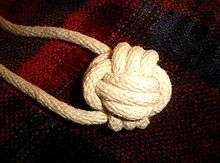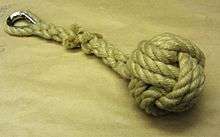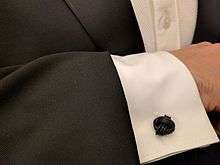Monkey's fist
| Monkey's fist | |
|---|---|
 | |
| Category | Stopper |
| Typical use | tied at the end of a rope to serve as a weight or an anchor |
| ABoK | #2202 |
| Instructions | |
A monkey's fist or monkey paw is a type of knot, so named because it looks somewhat like a small bunched fist/paw. It is tied at the end of a rope to serve as a weight, making it easier to throw, and also as an ornamental knot. This type of weighted rope can be used as a hand-to-hand weapon, called a slungshot by sailors. It was also used in the past as an anchor in rock climbing, by stuffing it into a crack. Nowadays it is still sometimes used in sandstone, e.g., the Elbe Sandstone Mountains in Germany.
Description

The monkey's fist is a spherical covering with six surface parts presenting a regular over-one-and-under-one weave. This weave is commonly doubled or tripled to present an appearance that superficially resembles a Turk's-head. Like the Turk's-head, the knot is tied with a single strand, but here the resemblance ceases. The Turk's-head diagram consists of a single line; the common monkey's fist diagram has three separate lines, which are best represented by three interlocking circles, in the best Ballantine tradition. To tie a knot on this diagram with a single strand, it is necessary to complete each circle in turn—that is, to double or triple it, as the case may be—and when this has been done to deflect the strand into another circle which is completed in turn before commencing the third and last circle.
The monkey's fist knot is most often used as the weight in a heaving line. The line would have the monkey's fist on one end, an eye splice or bowline on the other, with about 30 feet (~10 metres) of line between. A lightweight feeder line would be tied to the bowline, then the weighted heaving line could be hurled between ship and dock. The other end of the lightweight line would be attached to a heavier-weight line, allowing it to be drawn to the target easily.
The knot is often tied around a small weight, such as a stone, marble, tight fold of paper, grapeshot, or a piece of wood. However, this may be considered unsafe and therefore poor seamanship. The UK Maritime and Coastguard Agency’s (MCA) publication “Code of Safe Working Practices for Merchant Seamen”, Section 25.3.2, states that “heaving lines should be constructed with a “monkey’s fist” at one end. To prevent personal injury, the ‘fist’ should be made only with rope and should not contain added weighting materials”.
They should not be attached by metal or plastic clip to the heaving line. Some port authorities instruct linesmen to cut off monkey's fists that use these fastenings.
Tying

- A simpler knot to use as weight while throwing a rope is heaving line knot tied using the same 3 step method as a monkeys fist but with only one turn (light version) or one and a half turns (heavier version) in the first step, most of the rope weight provided by the turns at the second step, and as third step threading the end through the nearest bight pinched by the turns at the second step and tightening.
 heaving line knot, light version
heaving line knot, light version
Other applications

A monkey's fist can be used on two ends of a tow lines of one side a fish net which is then thrown from one trawler to another, allowing the net to be cast and set between two boats so the trawl can be used between the two, in pair trawling[2] where the tow or catch is negotiated between both parties. This makes it easier to catch fish given the greater surface area between both boats to turn around and catch missed fish from the sea much more quickly. Once all fish have been hauled up from the sea, tow lines of the fish net is returned by way of thrown both monkey's fists back to the host trawler. Alternatively, a monkey fist can be used as a weight of a heaving line thrown to over to an opposing ship to bring two ships together.[3]
Because of its use as a lifeline thrown from boat to boat, this knot was adopted as a symbol of solidarity among the hobo community.
Monkey's fists are commonly used as a convenient and unobtrusive method of storing and transporting precious gemstones.
A floating monkey's fist can be created by tying around a buoyant material such as cork or styrofoam.
- Step 1 of tying monkey's fist knot: tied flat
- Step 2 of tying monkey's fist knot: flat, with content in the middle
- Step 3 of tying monkey's fist knot: loosely wrapping content
- Step 4 of tying monkey's fist knot: loosely tightened around content
The three coils of cordage in a monkey's fist form in effect a set of Borromean rings in three dimensions. This is most obvious when tied flat.
It is also the most common knot used in a pair for cufflinks where it is considered a "silk knot."
Monkey fists have become popular as main deployment handles for sport parachute systems.
See also
Notes
- ↑ Ashley, Clifford W. (1944). The Ashley Book of Knots, p.353. Doubleday. ISBN 0-385-04025-3.
- ↑ Board on Science and Technology for International Development, National Research Council (1998). "Fisheries Technologies for Developing Countries". The National Academies Press. Retrieved 2009-06-28.
- ↑ Leishman, J. "Leg 1: Ft. Lauderdale to Bermuda - Across the Atlantic in 18 Trawlers." Sea Magazine, September 2004. Accessed 2009-06-28.
External links
| Wikimedia Commons has media related to Monkey fist. |
| Look up monkey's fist in Wiktionary, the free dictionary. |